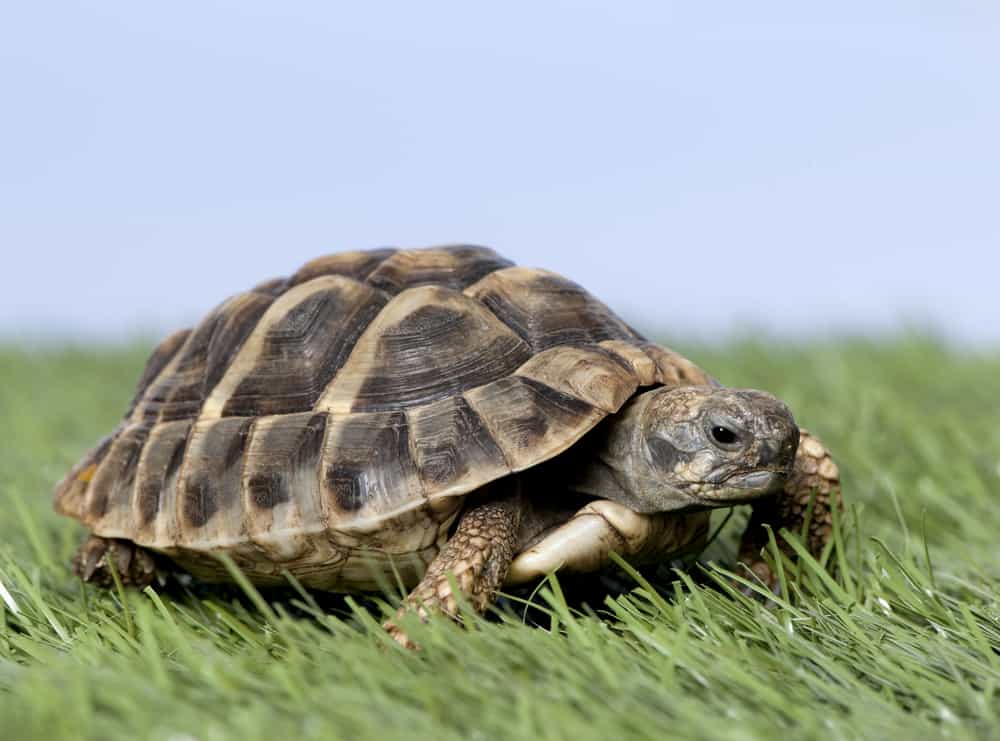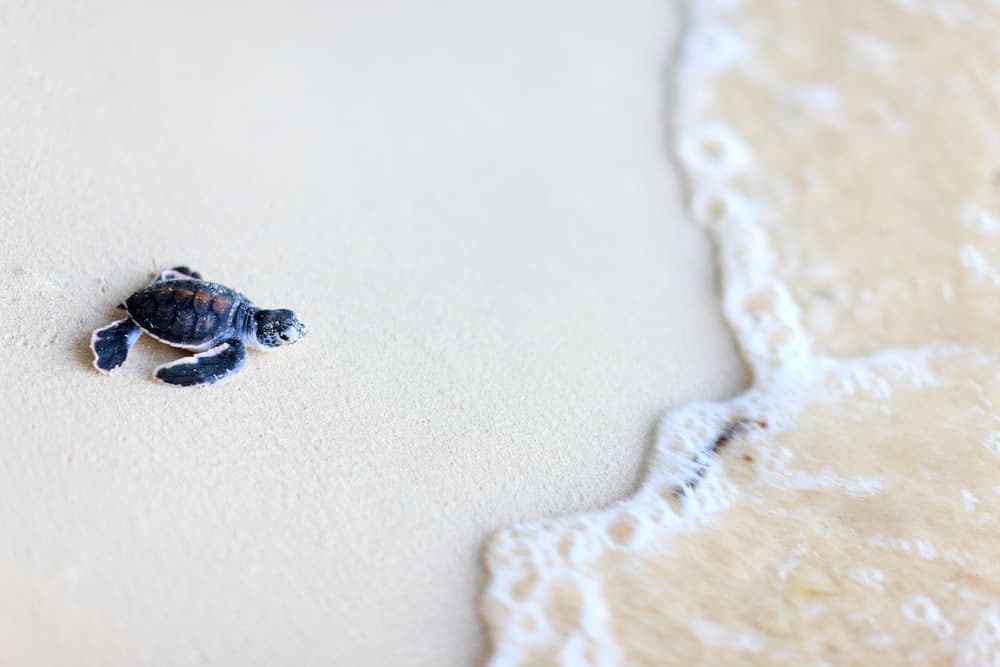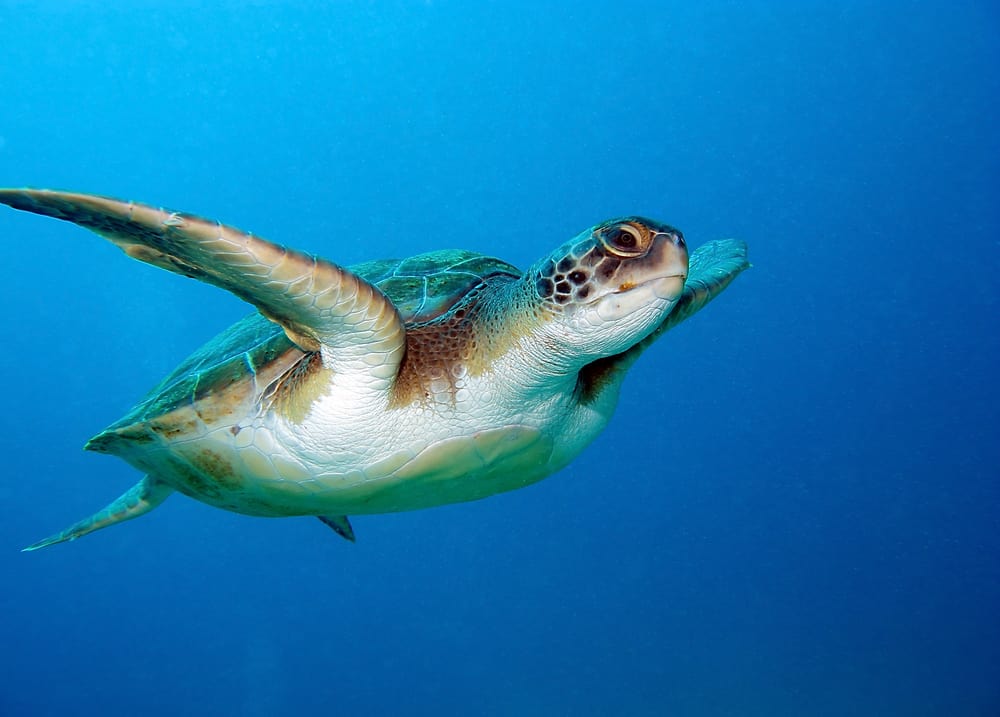Whether you need to learn about turtles for your homework or are interested in this species after seeing one for yourself, this post will tell you all the land and sea turtle facts you want to know!
If you have other questions you’d love to know the answer to, don’t miss out on our other animal facts for kids articles here.
Fast fun turtle facts
Turtles are reptiles. Their body is encased in a large shell, which offers them protection from those predators who might want to eat them for dinner. Members of the turtle family can live on land, in the sea or in freshwater.
What’s really clever and unique about turtles is the way their head can retract into their hard shell. We’d all like to have that ability sometimes, right? It’s pretty impressive – and just the start when it comes to cool facts about turtles.
Let’s move onto a quick-reference list of interesting facts about turtles!
Find some fun turtle stickers to add to your craft collection or school project here.
10 fun facts about turtles
Let’s dive into some quick-fire fun facts about turtles for kids.
- Turtles belong to the Testudines family of reptiles.
- They way they are grouped depends on the way their head retracts into the shell.
- Based on that, turtles are divided into Cryptodira and Pleurodira classifications.
- The shell of a turtle develops from their ribs.
- Different types of turtle can live on land, in the sea or even in freshwater.
- There are about 356 species of turtle across the world.
- Turtles are found on every continent except Antarctica.
- There are seven species of sea turtle in the oceans of the world.
- Turtle v tortoise? A tortoise is a member of the turtle family.
- Some turtle species date back to when dinosaurs roamed the earth!

Where do turtles live?
Turtles can live on land, in the sea or even in freshwater – which includes ponds, rivers and lakes. More turtles live in southern Asia and the southeast of North American than anywhere else. Each species has a preferred habitat.
The alligator snapping turtle, for example, is often found on the U.S. Gulf Coast, where there are slow-moving backwaters and streams. If you go to Costa Rica, you can see 4 different species of marine turtles. These are leatherback turtles, hawksbill turtles, green turtles and olive ridley turtles.
In south Asia, there are about seven species of Asian box turtles, which tend to live in streams and ponds within forests. Burmese and Indian flapshell turtles, meanwhile, are often found in rice paddies. Back in America, the saltwater terrapin is a turtle inhabiting coastal marsh and estuary areas.
Turtles live on all continents apart from Antarctica. They can live in freshwater such as ponds, streams, bogs, marshes, lakes and rivers. A marine turtle lives in the sea, while a land turtle cannot live in water.
Each type of turtle tends to have a specific area it calls home – or perhaps it would if only they could speak!
What do turtles eat?
As with where they live, different species of turtle tend to eat different things. Some, such as snapping turtles, consume a lot of meat like frogs, snakes, fish and even small birds. Cooter turtles are mostly vegetarian, but are omnivores, while tortoises are herbivores that eat only plants.
Many lie between these two extremes, and will often seek out their preferred food. This might be marine grasses, insects, snails, or crayfish, for example. Yum!
What about baby turtles?
Turtles lay eggs, which later break open to reveal hatchlings. This often happens at the same time of the year. The eggs will generally be laid so the hatchlings can develop during the best weather conditions.
This is why beaches where turtles nest can be closed to humans for certain months. So if you go on holiday to a place like the south west coast of Turkey or the Florida Keys, for instance, you cannot access certain beaches while the resident turtles are nesting there.
The number of eggs laid varies depending on the type of turtle. Some lay just one or two, but for others it can be more than 150! Most kinds lay eggs once a year, but with certain species it can be a few times.
In some cases and species, a turtle can live to 100 or more! They can be traced back to between 250 and 300 million years ago.

save the turtle
Did you know that you can adopt a sea turtle via the WWF? This is because many turtles are now critically endangered.
Climate change and human behaviour has sadly caused this. Almost all sea turtles are endangered, and three sea species are on the critical list. This means they’re at severe risk of becoming extinct in the wild.
Fortunately those who can are trying to prevent this from happening, but there’s a lot of work still to be done.
Check out this range of books on turtles for kids, they are awesome!
Fun turtle facts by species
As you can see from reading this article so far, turtles vary in where they live and what they eat according to their species. Here are some fun facts about sea turtles, land turtles and freshwater turtles.
Green sea turtle facts
- This is the second largest type of sea turtle and the biggest of the hard shell turtles.
- Green turtles weigh about 135 to 160 kilos (or 300 to 350 pounds).
- They are about 90 to 120 centimetres long (or 3 to 4 feet).
- Green sea turtles like marine grass best, but will eat algae.
- You can find them in Australia on the Great Barrier Reef.
We LOVE these sea turtle soft toys – check them out here!
Hawksbill turtle facts
- This is a critically endangered type of sea turtle.
- They tend to live near coastline in the Pacific, Indian and Atlantic Oceans.
- Hawksbill turtles lay about 150 eggs per clutch.
- They usually live for 30 to 50 years.
- These turtles can be found in parts of Queensland and Western Australia.
Loggerhead turtle facts
- The scientific name of this turtle is Caretta Caretta.
- Loggerhead turtles usually live for over 50 years.
- These omnivores prefer seafood like crabs, mussels and clams.
- These turtles can travel up to 12,000 kilometres to lay their eggs.
- Loggerhead turtles exist in QLD, NSW, NT and WA.

Snapping turtle facts
- This is a large freshwater turtle that likes slow-moving water.
- The snapping turtle has super strong jaws.
- Its scientific name, Chelydra Serpentina, comes ‘tortoise’ in Greek and ‘snake’ in Latin.
- These omnivores eat a variety of plants and animals.
- You can find Australian snapping turtles in the rivers of northern and north eastern Australia.
Leatherback turtle facts
- Leatherbacks are the biggest turtles in the world.
- Their shells are leathery and soft, not hard like other turtles.
- Leatherback turtles can live in colder seas than other species.
- Jellyfish is the favourite food of the leatherback.
- Leatherback turtles may visit beaches in various Australian states.
Olive ridley sea turtle facts
- This is the second smallest type of sea turtle.
- There are more olive ridley turtles on than any other kind of sea turtle.
- Unlike others, this turtle likes water up to 150 metres deep (500 feet).
- In some areas, olive ridleys are hunted for their skin, meat and eggs.
- They live on the Great Barrier Reef plus in other parts of QLD, NT and WA.
Red eared slider turtle facts
- This turtle is also known as the red-eared terrapin.
- It’s a popular pet worldwide, especially in the US.
- The red eared slider likes rivers, lakes and marshes with muddy bottoms.
- This is a very adaptable turtle that can be invasive.
- Because of this illegal to import, sell, keep or release red-eared sliders in Australia.
information about turtles for kids
We hope you’ve enjoyed reading these fun facts about turtles. There are so many interesting facts about sea turtles, land turtles and freshwater turtles to find out about!
The best thing we can all do to conserve these beautiful creatures is to learn about them, educate others and leave nesting turtles alone when asked to do so. Turtles have been around for so many millions of years. Wouldn’t it be a shame if kids in the future could only learn loggerhead, leatherback or green turtle facts as part of a history lesson?
You can buy cool turtle stickers here – don’t forget to ask your parents’ permission!
Discover more of our fun facts for kids animal guides below.
- Quokka Facts for Kids
- Ant Facts for Kids
- Crocodile Facts for Kids
- Dolphin Facts for Kids
- Echidna Facts for Kids
- Bee Facts for Kids
- Australia’s Deadliest Animals Facts for Kids
- Cheetah Facts for Kids
- Endangered Animals Facts for Kids
- Kangaroo Facts for Kids
- Possum Facts for Kids
- Koala Facts for Kids
- Dog Facts for Kids
- Cat Facts for Kids
- Butterflies Facts for Kids
- Dingo Facts for Kids
- Penguin Facts for Kids
- Whale Facts for Kids
- Wolf Facts for Kids

